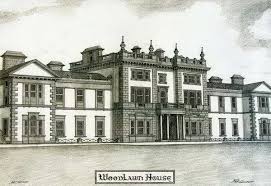Woodlawn House
Original home of of the Trench family which remains extant..
Gerry Costello
Roderick Trench presumes that the 2nd Ashtown, who was born and raised at Sopwell, moved to Woodlawn in 1840 after inheriting the title on the death of his uncle. The 1840 map shows the house and lakes. The house was extended in the 1850s when the 3 storey house was refaced and embellished in the Italianate style, and enlarged by 2 two-storey wings three-bay wings. Building on such a lavish scale was rare in post-famine Ireland And further large sums in the late 1800s on gardening projects, outbuildings, land drainage and livestock. This created employment for up to 300 people at times. However he ran into financial difficulties and by 1922 was forced to action off moveable property The most famous owner, the first Lord Ashtown, was powerful enough to have the new Dublin-Galway railway line diverted to go through his lands. He built a large and majestic railway station that is still in existence today. In fact his building programme included many other fine buildings of architectural beauty that still stand today including a Protestant Church, Gamekeepers Lodge, a family Mausoleum, a Ice House, artisan cottages and above all Woodlawn House itself. In fact over 150 years later, there are few other buildings of note in the area. The team that produced the independent American film ‘The Blair Witch Project’ came to Ireland to make a documentary on the most haunted houses in Ireland. They stayed in many, but apparently found Woodlawn House to be the scariest!
The title Lord Ashtown was created in 1800 for Frederick Trench, with remainder to the heirs male of his father. He was elected to the Irish House of Commons for Portarlington from 1798 to 1800. He also served as the borough’s representative in the United Kingdom Parliament for a few months in 1801. In 1801 he was raised to the Peerage of Ireland as Baron Ashtown, with remainder to the heirs male of his father Frederick Trench. This was a so called “Union peerage”, a reward for Trench’s support for the Union between Ireland and Great Britain, which he had initially opposed. You get the flavour from a contemporary report.
Contemporary Report:
Mr Trench declared, in presence of a crowded House, that he would vote against the minister, and support Mr Ponsonby’s amendment. “This,” observes Sir Jonah Barrington, who was an eye-witness of the transaction, “appeared a stunning blow to Mr Cooke, who had been previously in conversation with Mr Trench. He was immediately observed sidling from his seat, nearer to Lord Castlereagh. They whispered earnestly; and, as if restless and undecided, both looked wistfully at Trench. At length the matter seemed to be determined on. Mr Cooke retired to a back seat, and was obviously endeavouring to count the House – probably to guess if they could that night dispense with Mr Trench’s services. He returned to Lord Castlereagh; they whispered, and again looked at Mr Trench. But there was no time to lose; the question was approaching. All shame was banished; they decided on the terms, and a significant glance, obvious to everybody, convinced Mr Trench that his conditions were agreed to. Mr Cooke then went and sat down by his side: an earnest but very short conversation took place; a parting smile completely told the House that Mr Trench was satisfied. These surmises were soon verified. Mr Cooke went back to Lord Castlereagh; a congratulatory nod announced his satisfaction. But could any man for one moment suppose that an M.P. of large fortune, of respectable family, and good character, could be publicly, and without shame or compunction, actually seduced by Lord Castlereagh under the eye of 220 gentlemen? In a few minutes Mr Trench rose to apologise for having in-discreetly declared he would support the amendment. He added, that he had thought better of the subject; that he had been convinced he was wrong, and would support the minister.” Mr Trench accordingly became Lord Ashtown.
Lord Ashtown married Elizabeth, daughter of Robert Robinson, in 1785. They had no children. He died in May 1840, aged 84, and was succeeded in the barony according to the special remainder by his nephew Frederic. Lady Ashtown died in 1844. He was succeeded according to the special remainder by his nephew, the second Baron (the son of Francis Trench). His grandson, the third Baron (son of Frederic Sydney Charles Trench, eldest son of the second Baron), sat in the House of Lords as an Irish Representative Peer from 1908 to 1915.













Comments about this page
Hi,
Woodlawn Heritage Group here. Do you mind if we put a link to your article on Woodlawn Heritage Page? We are one of the new groups on the community heritage website.
Kindest Regards,
Bernie
woodlawnhg@gmail.com
Bernadette, no problem at all on that score. Go ahead and link anything you wish. Links are good for all of us.
Best regards,
Gerry
Add a comment about this page